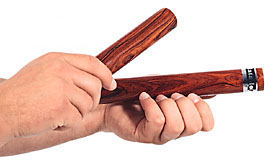"A good drummer listens as much as he plays." ~ Indian Proverb
Percussion Store Drummers Drum Lessons Drumming FAQs
International Shipping
"A good drummer listens as much as he plays." ~ Indian Proverb
Percussion Store Drummers Drum Lessons Drumming FAQs
International Shipping
![]()

![]()
Drums & Percussion
Drum Sets & Cymbals
Cymbals, Hardware & Accessories
Latin Percussion
LP Hardware, Accessories & Replacement Parts
Middle-East Drums & Percussion
African Drums & Accessories
Chinese & Eastern Drums & Percussion
Irish Drums & Percussion
Orchestra Bells & Chimes
Drum & Percussion Hardware
![]()
The Name:
The Clave (pronounced clah' vay) is the traditional Afro-Cuban instrument used to play the clave rhythm.
Claves create a sharp, cracking sound that pierces through every other sound on stage.
Names of the Two Clave Sticks: The stick that is stuck is called the clave; the stick that strikes is the striker.
Clave is the rhythmic pattern that forms the basis of Latin music. Clave is phrased in what is known as a 3-2 or 2-3 feel (three notes in the first four beats & then two notes in the second for beats or vice versa).

The clave is held by the
fingertips and thumb (see picture). It can rest slightly on heel of hand,
but should not rest on the palm. There should be about an inch of space
between the clave and the palm of the hand. This space creates a sound
chamber, which allows the clave to best vibrate & project its sound. The
striker is held by one hand and is struck against the
clave, which is held by the other.
3-2 Son Clave in Music Notion Form

3-2 Son Clave in Rhythm Chart Form (same rhythm as above, in chart form)
|
1 |
+ |
2 |
+ |
3 |
+ |
4 |
+ |
1 |
+ |
2 |
+ |
3 |
+ |
4 |
+ |
|
X |
X |
X |
X |
X |
Hand Drumming & Ethnic Percussion - Online Lessons
Global Percussion Classes & Private Lessons